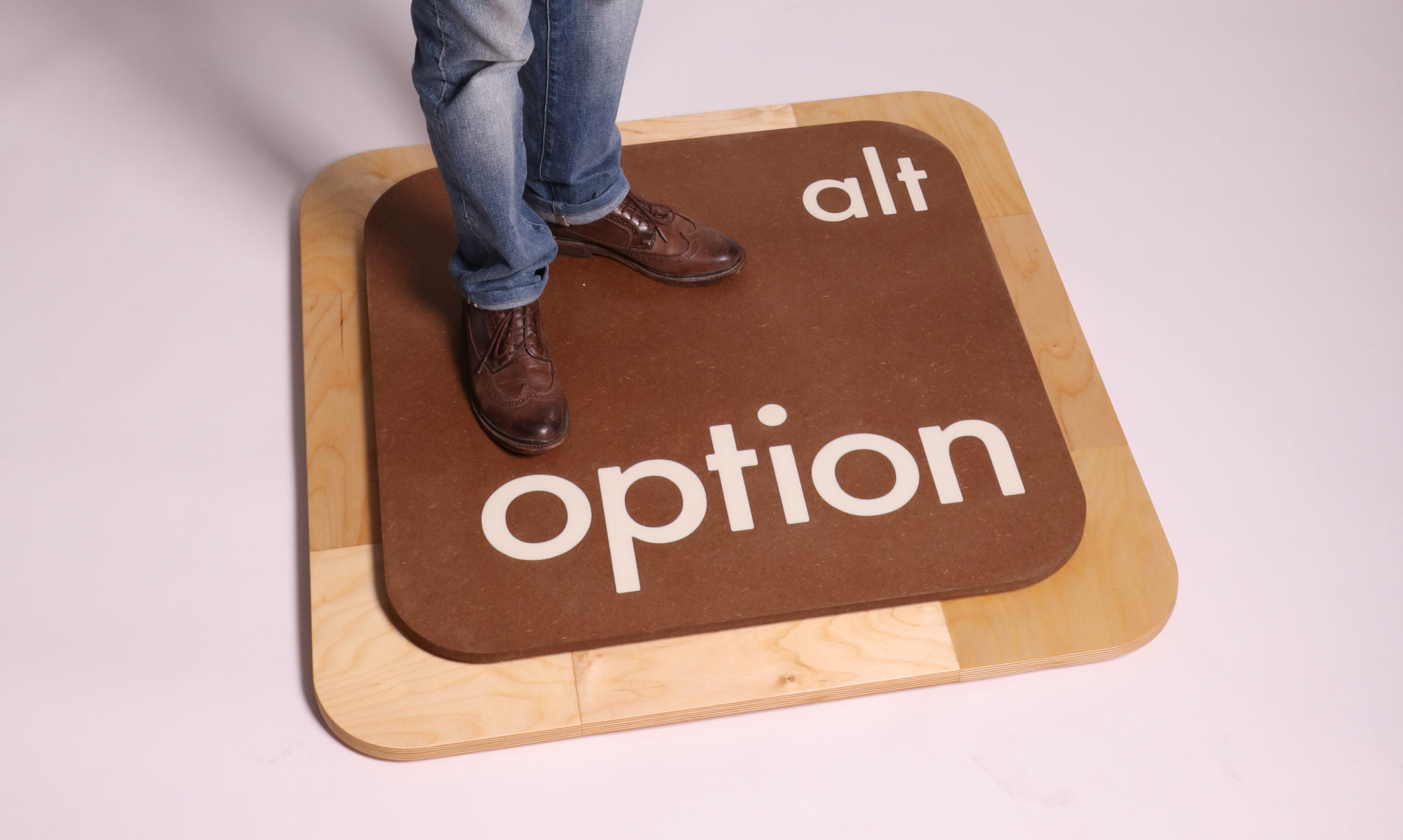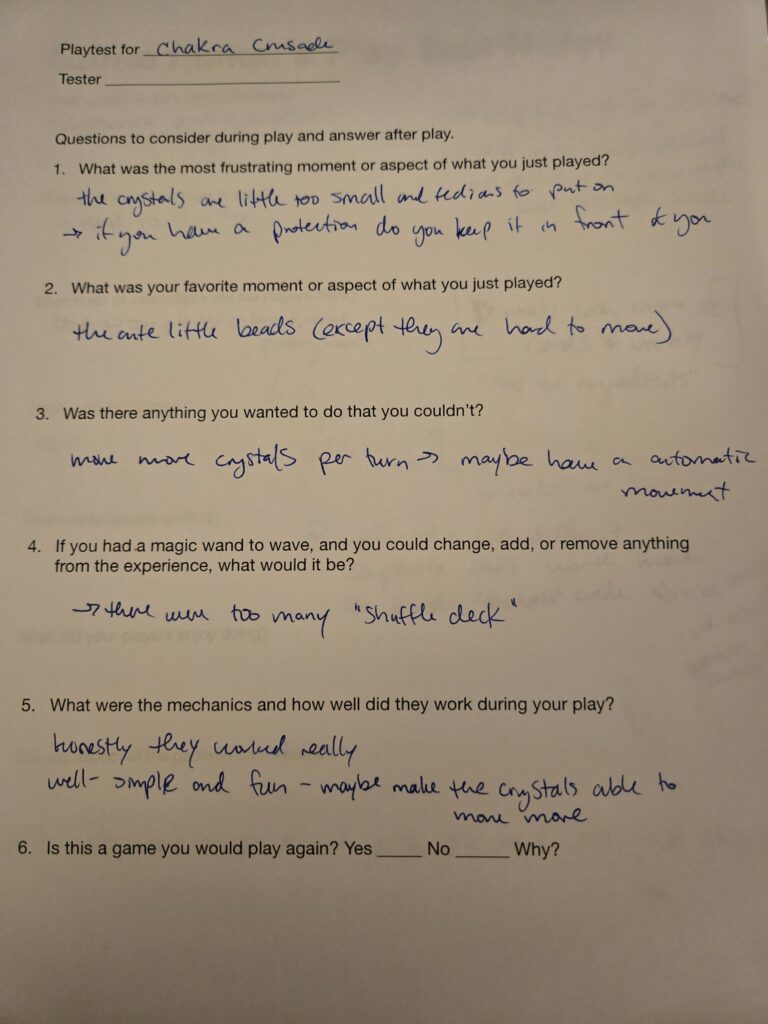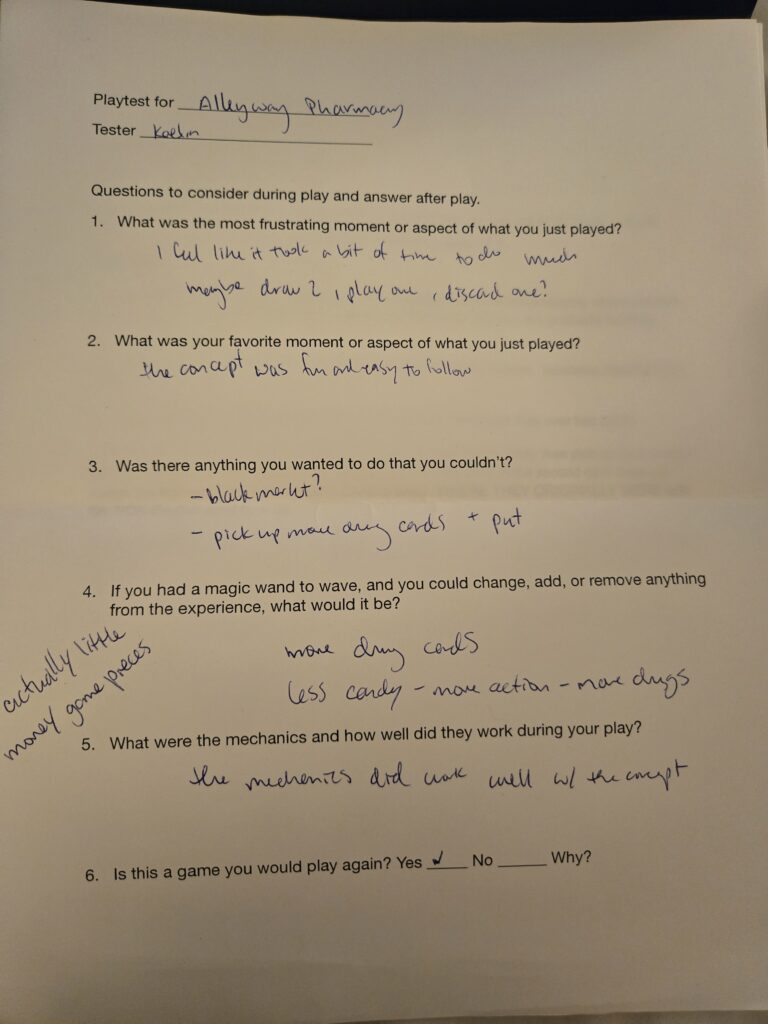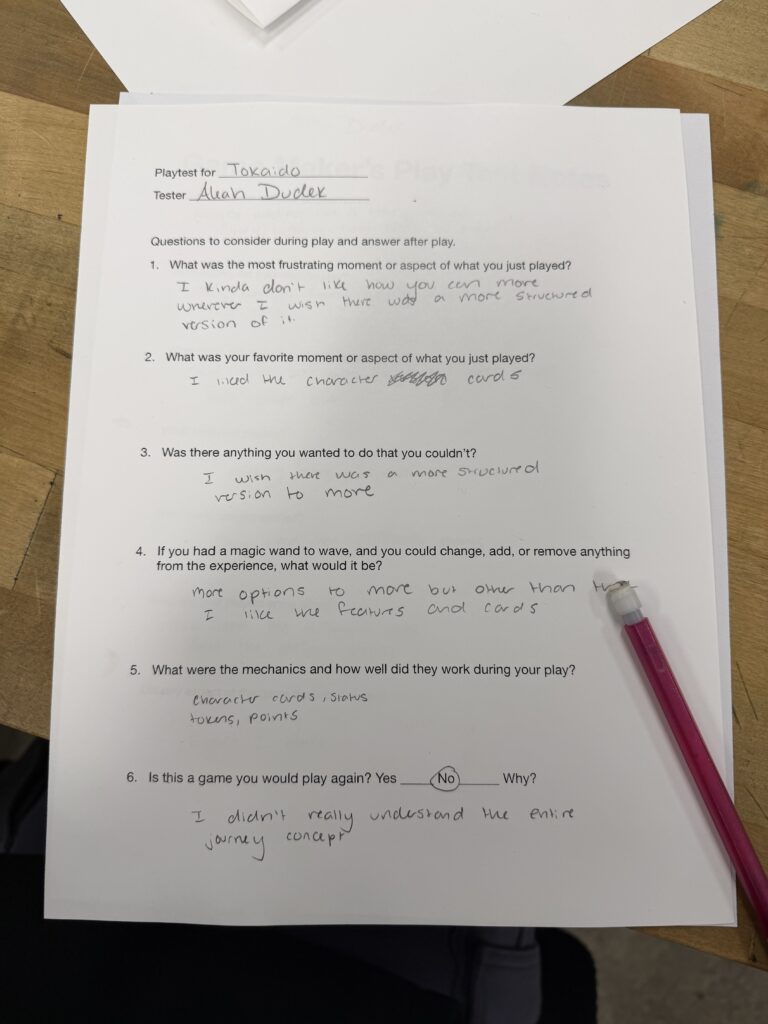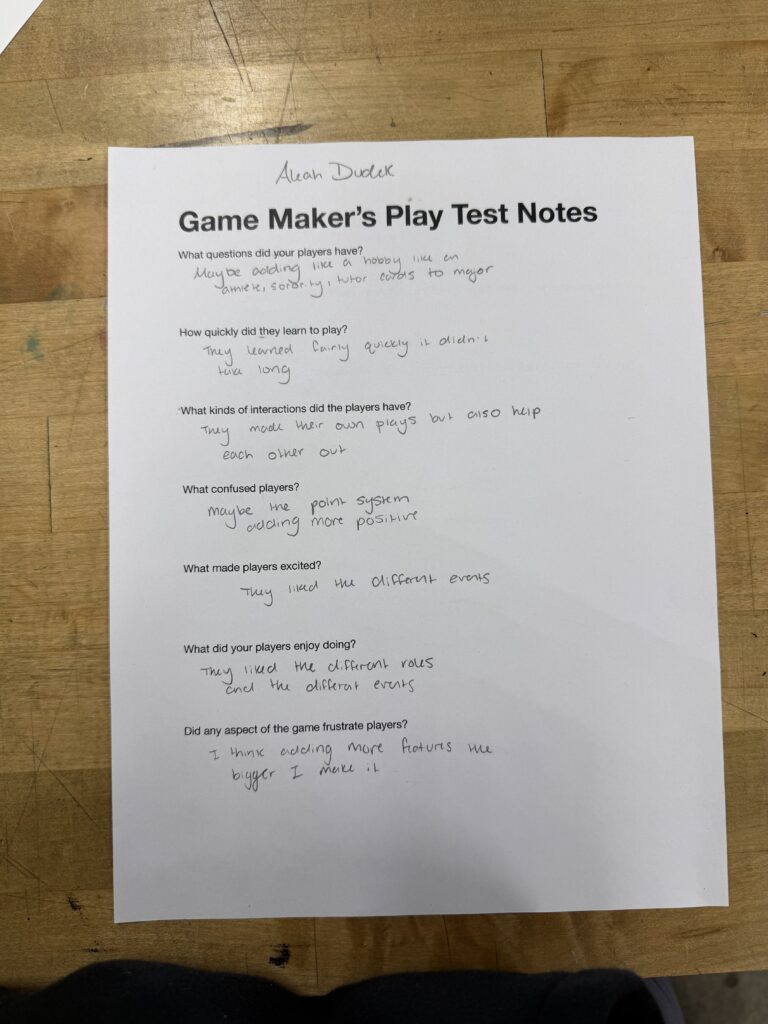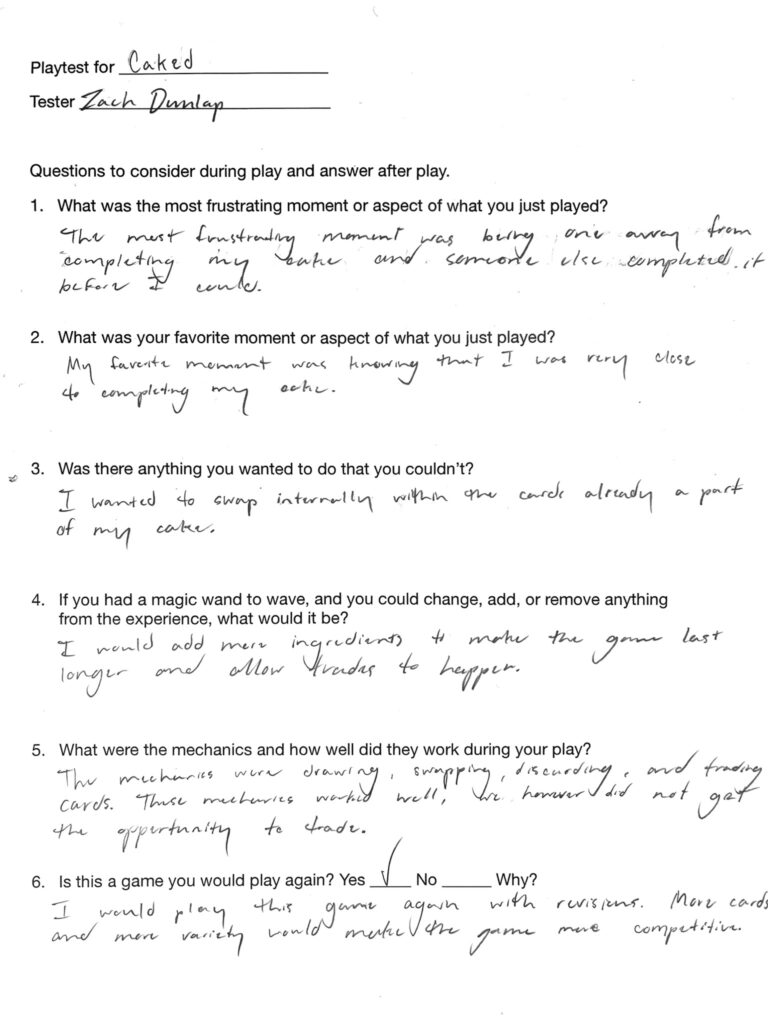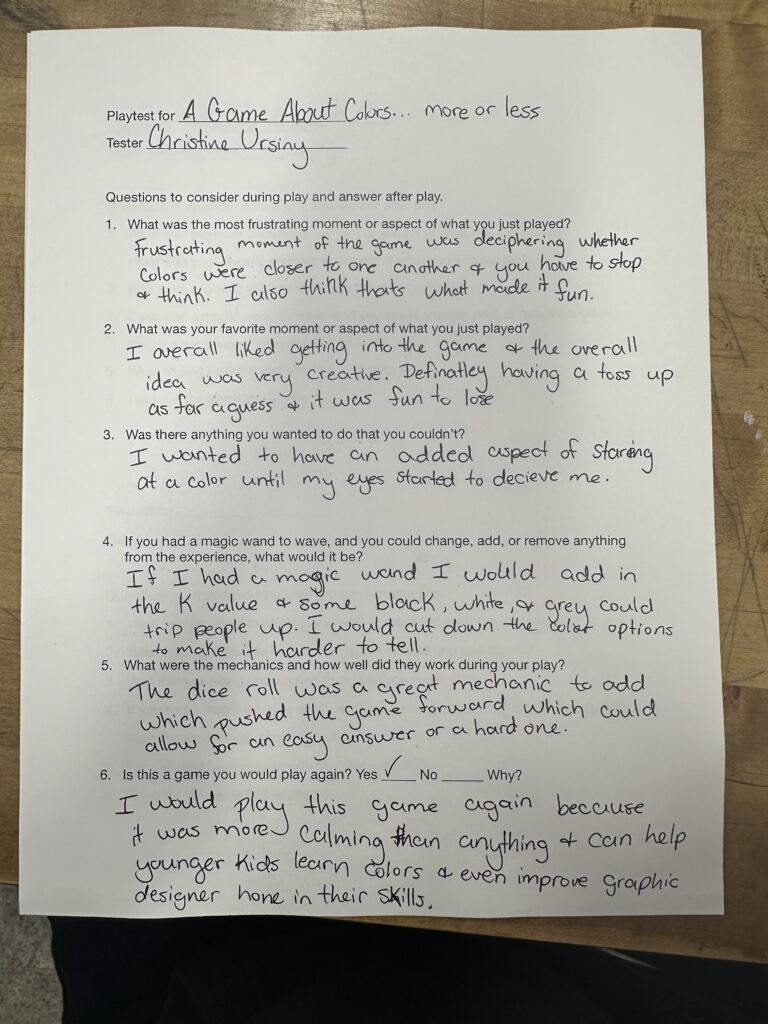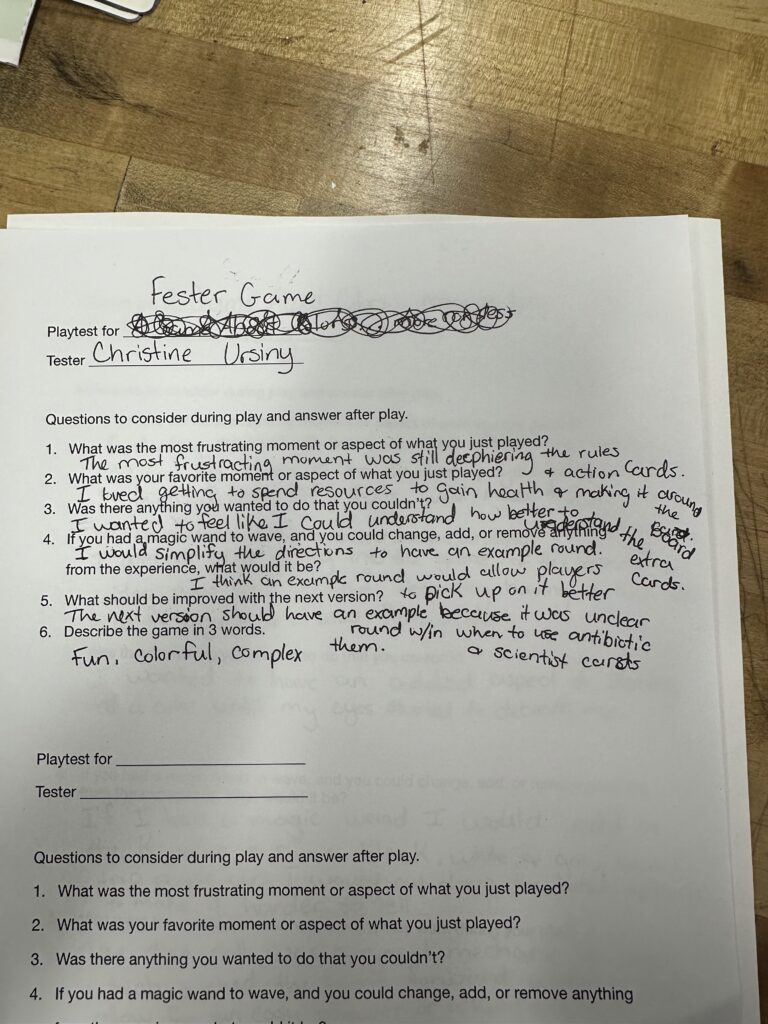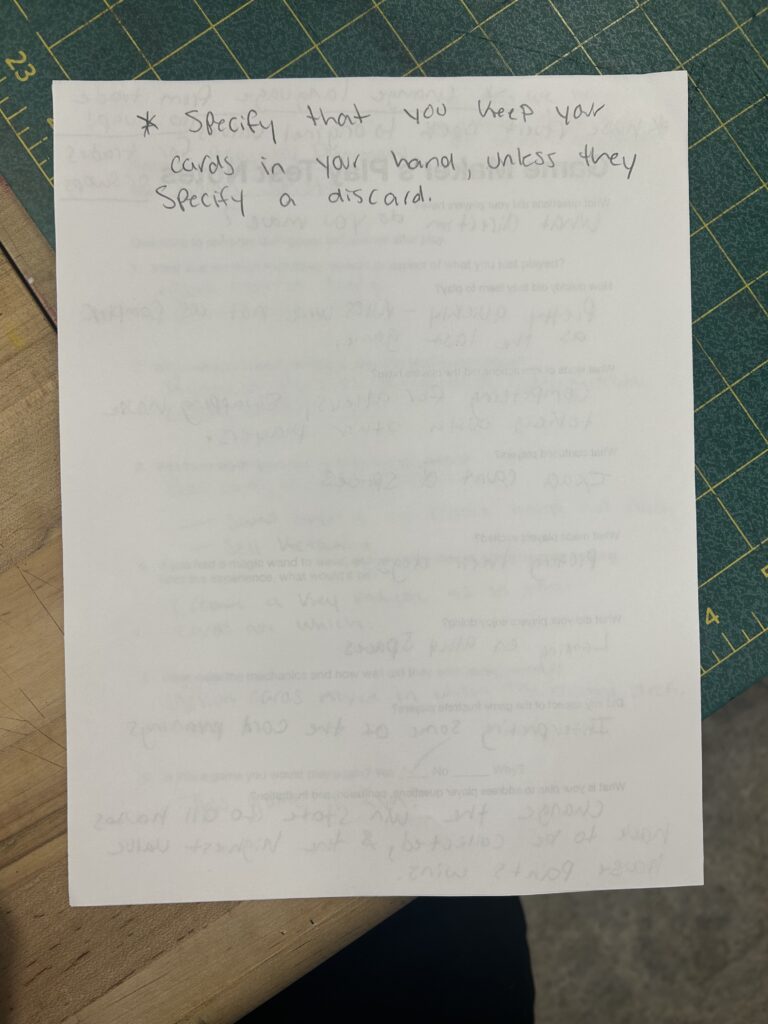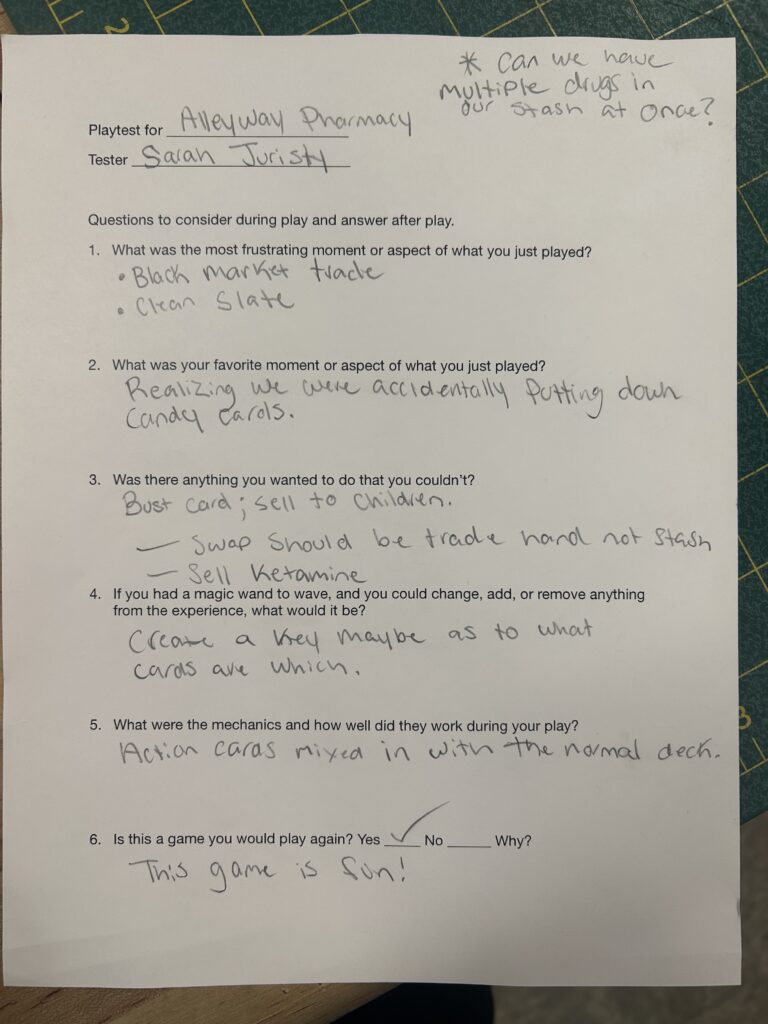Prototype Test Response – Chakra Crusade
Prototype Testing Response – Alleyway Pharmacy
Game Testing – Tokinado
Was it fun?
- The game was pretty fun, and I enjoyed the design of the game. I thought it was super pretty, and fit the vibe of the game. It was super engaging while not difficult to understand. It was easy to talk to other players and still focus on the game.
What were the player interactions?
- The player interactions was not being able to be on the same space as another player. Players were going against each other by getting as many points as possible, and having to deal with managing the amount of tokens they had.
How long did it take to learn?
- The game took about 20 or so minutes to learn. At first, it was a little hard to understand and was a lot to digest since there was a lot of card decks and moving pieces. After we starting to get the game, it became more fluid. Players were making better decisions on their turn as we progressed.
What was the most frustrating moment or aspect of what you just played?
- The most frustrating part of Tokinado was not being able to collect tokens or coins as easily. I felt that I didn’t completely understand the coin collection rules, and was giving away my tokens and never gaining any.
What was your favorite moment or aspect of what you just played?
- My favorite moment was being able to move my colored circle piece up on the number spaces. Or having the ability to get to the restaurant stage, and picking out your meal. I really loved the theme of the game as well. I enjoyed how you were backpacking across Japan, and thought the concept was extremely cool.
Was there anything you wanted to do that you couldn’t?
- I really wanted to add my coin collection, and I couldn’t or didn’t know how to. I was trying to figure out the system of the game, but with the limited time we had it was harder to grasp.
If you had a magic wand to wave, and you could change, add, or remove anything
from the experience, what would it be?
- I would change how the coin collection would go. Maybe add a feature of coin collection or easier ways to get more coins.
Is this a game you would play again? Yes _____ No ______ Why
- Yes, I would play this game again. I love the style of the game and the adventure it gives the players. I enjoyed playing the game and I liked the style that the last player or player behind everyone went.
Analyze the game using the 3 act structure.
- the first act is reading the instructions and understanding the objective of the game. Each player is figuring out what their character does and how their turns work. The second act of the game is when the instructions are figured out and the rhythm of the game is found. In this act, players are thinking out their next moves and intentionally placing their pieces on spaces they think will be beneficial. The third act is when points are being rounded up and players are coming to the end of the board. We did not get to this stage since class ended.
What are the collaborative and or competitive aspects of the game?
- The collaborative aspect of the game was picking a meal out of the card deck that another player picked up. The competitive side of was managing your coins and choosing spaces that another player may have wanted or getting their first.
What is the game’s metaphor and which of the game’s mechanics standout?
- The games mechanics is game pieces, the board itself, and card decks. The mechanics helped players figure out where to go and what to do. For instance, whatever you landed on had a certain color which decided what deck to choose from. The games’ metaphor was
Describe the game in 3 sentences or in the form of a haiku.
- Travelers hiking
- Sea to Sky to feel alive
- Japan waits ahead
Question Set – Week 8
6 Game Ideas – Week 5
5 Game Ideas – Week 4
week nine questions
Playtest Questions: A Game About Colors, More or Less…, Caked
Survive the Semester Play test Questions
A Game about Colors… more or less Review
Fester Game Review
Caked Game Review
Part 3 Question Set
- Question Set 1
- what is the difference between a game designer and a game developer? – The difference between a game designer and game developer is the game designer creates the mechanics for the game and figures out rules and development of the game. The designer creates the finished Skelton of the game which is then sent to a game developer who makes the game more marketable. The whole point of a game developer is make the game better. In part 3, they refer to game designer as the author and a game developer as the book editor (game editor to make it better). A game developer has the power to change a designers mechanic if it will lead to the game to be more efficient and fun.
- what commonly occurs during the game development process?
- – What commonly occurs in game development process is initial play testing, rules, blind play testing, and titles/theming. In initial play testing the designers main focus to see the game from a “newbie” perspective. They are trying to figure out the major flaws in the game and fix the flow of it. This stage is where the game maker sees how much they can simplify the rules in order to avoid the players having an automatic bad experience with the game. Rules come into play where it helps the mechanics of the game flow better and more comprehensible. They are supposed to be eye catching to the player and make it easy for them to understand the game. The rules are acting as a communicator and a reference for the users. Blind testing is when the game is polished enough for a group of people to pick up the game and be able to fully grasp the game and play it. The maker is taking notes of what needs to be tweaked. Finally, there is titles and theming which is theme that the game is revolved around. For example, Dominion is a deck building game. The game has a story or theme behind it. We talked briefly about my last prototype theme and why its ok to play it (talked about Breaking Bad and the crossing the boarders game).
- what are the challenges of balancing a game?
- – The challenges of balancing a game is ensuring that no action is completely unjust or unfair. There must be different ways to combat a negative action and making sure a positive action is too much. For example, adding a time restraint in your game or adding difficult cards in the deck will help with balancing the easier/hard parts of the game. The second challenge is balancing the game with the idea of cost. No card should be unfair or too overpowered. Peterson highlights that the card can be used in the game but must be developed extremely well.
- what should every player of your game believe? why?
- – Every player of a game should believe that they are able to win. No player should feel that they don’t have an opportunity to win right off the bat, and if so that’s where there is a problem in the format of the game or in the rules. Peterson highlights that this is VERY important in when designing a game. When a player loses interest in losing then the game is over in their head, and you have no longer engaged this user. Not giving the user an opportunity to feel confident in winning is the moment the game lost its engagement.
- how can you avoid stealing players fun?
- – You can avoid stealing players fun by getting players to interact with each other. Peterson believes that the players should be able to choose who the winner is. This gives each player the opportunity to be more engaged in the game and feel more control over how the game ends.
- what 10 maxims should you follow when writing rules?
- Use no intermediary terminology: “Call things what it is.” Avoid made up names or labels of people (call people, people or dice, dice).
- Use real words: make rules easy to understand and they must be consistent throughout the game
- Make no more work than necessary: don’t overcomplicate the mechanics and rules of the game. Cut out all the rules that make it harder to learn or uneccesscary to learn
- Add flavor (but not too much): Be aware of how much flavor you can add to your game, and make sure its the right amount (not too much, not too little)
- Make your text no smarter than your reader: make it easy to read the rules, players are more willing to play a game that is easier than confusing.
- Discard rules that cannot be written: Remove a rule if it is too complicated or complex to write. You may want to write the rules because you like how it goes with the game, but for the players sake it has to be able to explain.
- Take a breath: if text is getting complex and long, break it up
- Go easy on the eyes: rules must be readable
- Play test your final version: look over your rules in a final playtesting and make sure everything is easy to understand.
- Fix it in the FAQ: Make clarifications
- Question Set 2
- how has play testing changed your game?
- – Play testing has changed my game because it allowed me to see the speed of the game and come up with different actions or rules to improve the game. Playtesting highlights all of the issues in your game that you didn’t think of when preparing it. So, playing the game and taking notes allows you to make changes to the game so its is better.
- who from class would you like to play test your next game or version 2 of your first game?
- – I would like to play test with a different group of people and have one person from the group prior to join and see the alterations of the game. I think having one person from the first testing will allow feedback to me, and see what they liked/disliked in the first testing and the second.
- who is the audience for your game?
- – The audience that my game is for is high school and up. I think especially my second prototype game was more rated and not kid friendly. I am aiming to target the audience that is interested in a GTA ish world or enjoy that kind of games.
- who should play test your game outside of class?
- – My soccer friends are really excited to play test my games outside of class. They have been constantly asking me to bring it over when I have the time.
